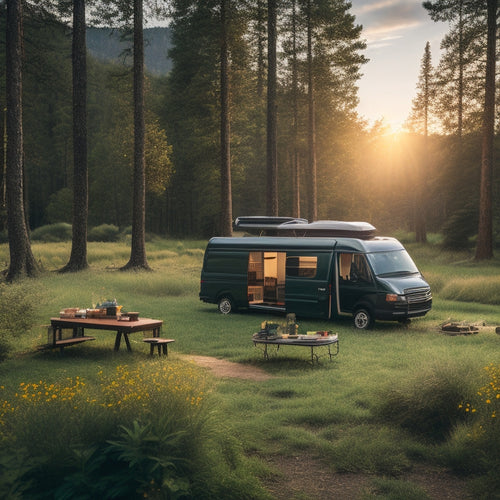
5 Best Practices for Long-Lasting Sustainable Batteries
Share
To maximize the lifespan of your batteries, you should optimize charging cycles by maintaining a charge level between 20% and 80% and pacing charging cycles to avoid extreme conditions. Regularly monitor battery health by tracking state of health, capacity, voltage, and internal resistance. Avoid extreme temperature fluctuations by maintaining an ideal temperature range of 20°C to 30°C and using thermal management techniques. Keep your battery software and firmware up-to-date to guarantee peak performance and security. Finally, store idle batteries properly in a cool, dry place away from metal objects. By following these best practices, you'll be well on your way to sustainable battery maintenance - and there's more to explore on this critical topic.
Key Takeaways
• Optimize charging cycles by maintaining a battery level between 20% and 80% to minimize wear and tear.
• Regularly monitor battery health by tracking state of health, capacity, voltage, and internal resistance.
• Avoid extreme temperature fluctuations by maintaining an ideal temperature range of 20°C to 30°C.
• Regularly update firmware and software to ensure efficient and secure battery operation.
• Store idle batteries properly in a cool, dry place away from metal objects and extreme temperatures.
Optimize Charging Cycles Wisely
By understanding how charging cycles impact battery lifespan, you can optimize your charging habits to maximize the overall health and sustainability of your batteries.
Cycle counting is important, as it helps you track the number of charge/discharge cycles your battery has gone through. This information is vital in determining the battery's remaining capacity and overall health.
To prolong your battery's lifespan, it's important to adopt charge pacing techniques. This involves avoiding extreme temperatures, high charge rates, and deep discharges, which can cause significant degradation. By pacing your charging cycles, you can reduce the stress on your battery, thereby increasing its overall lifespan.
Additionally, try to keep your battery level between 20% and 80% charged, as this helps minimize wear and tear.
Monitor Battery Health Regularly
You can safeguard your battery's health and sustainability by regularly monitoring its state of health. This involves tracking its capacity, voltage, and internal resistance to identify potential issues before they escalate. This essential approach enables you to detect anomalies and take corrective action to prevent battery degradation.
Calibration is vital in ensuring the accuracy of your monitoring efforts. By calibrating your diagnostic tools, you can trust the data you're collecting and make informed decisions about your battery's maintenance. Diagnostic tools, such as battery management systems, provide valuable insights into your battery's performance, allowing you to pinpoint areas that require attention.
Regular monitoring also helps you identify opportunities to optimize your charging cycles, which in turn extends the lifespan of your battery. By staying on top of your battery's health, you can prevent unexpected failures, reduce downtime, and minimize the environmental impact of battery replacement.
Avoid Extreme Temperature Fluctuations
Extreme temperature fluctuations can greatly shorten your battery's lifespan and compromise its overall performance, as lithium-ion batteries are particularly sensitive to temperatures outside the ideal range of 20°C to 30°C.
You can't control the ambient temperature, but you can take steps to minimize the impact of temperature fluctuations on your battery. Effective thermal management is essential to maintaining peak battery performance. By using insulation techniques, you can reduce heat transfer and keep your battery within the recommended temperature range.
This can be achieved through the use of thermal insulation materials, such as foam or fiberglass, which can be placed between the battery and the surrounding environment. Additionally, you can implement active cooling or heating systems to regulate the temperature.
By taking these measures, you can ensure that your battery operates within the desired temperature range, maximizing its lifespan and performance.
Update Firmware and Software
Regularly updating your battery's firmware and software guarantees that it operates with the latest performance enhancements and security patches, building on the foundation of a well-managed thermal environment. This ensures your battery stays optimized, efficient, and secure.
To keep your battery up-to-date, you should:
-
Enable cloud updates to receive automatic firmware security patches, ensuring your battery stays protected from potential vulnerabilities.
-
Regularly check for software updates, as they often include performance enhancements and new features that can improve your battery's overall lifespan.
-
Set reminders to update your battery's firmware and software regularly, so you never miss a critical security patch or performance enhancement.
Store Batteries Properly When Idle
When not in use, idle batteries should be stored in a cool, dry place away from metal objects to prevent accidental short-circuiting and prolong their lifespan. You'll want to make sure the storage area is free from moisture, extreme temperatures, and physical damage.
A clean environment is important for proper storage, so keep the area dust-free and avoid storing batteries near chemicals or corrosive substances.
Avoid mixing different battery types or brands in the same storage container, as this can cause unwanted chemical reactions. Instead, store each type separately, making it easier to track their condition and performance.
Keep the storage container away from direct sunlight, heat sources, and open flames. You should also avoid stacking batteries on top of each other, as this can cause pressure points that may lead to damage.
Frequently Asked Questions
Can I Use Any Charger for My Battery or Are There Specific Ones?
Did you know that 70% of battery damage is caused by improper charging? You can't just use any charger; verify compatibility and look for voltage regulation to prevent overheating, as mismatched chargers can harm your battery's lifespan.
How Often Should I Calibrate My Battery for Optimal Performance?
You should calibrate your battery every 3-6 months to maintain peak performance, as infrequent calibration can lead to battery aging, reducing its overall lifespan and requiring more frequent recharging.
Are There Any Specific Battery Types Better Suited for Extreme Environments?
When venturing into extreme environments, you'll want batteries built like rugged outposts, with thermal management systems that shield against scorching heat and icy cold, ensuring your devices stay powered and unfazed.
Can I Overcharge My Battery or Will It Stop Charging Automatically?
You'll be relieved to know that most modern batteries, like lithium-ion, have built-in protection circuits that prevent overcharging, safeguarding your battery lifespan and ensuring you get the most charge cycles out of your battery.
Are There Any Government Regulations on Sustainable Battery Disposal?
You'll be glad to know that yes, governments regulate sustainable battery disposal, ensuring responsible recycling to minimize environmental impact; for instance, the US has the Battery Recycling Act to reduce toxic waste and promote eco-friendly practices.
Related Posts
-

Top Picks: Van-Friendly Panel Kits to Buy Online
You're about to hit the open road, and you need a reliable source of power to keep your van's essentials running smoo...
-

Why Eco-Friendly Rides Are the Future of Commuting
As you seek alternatives to traditional vehicles, you'll find eco-friendly rides are not only convenient and cost-eff...
-

What Eco-Friendly Vehicles Can You Buy Online Today?
You can now browse and buy a wide range of eco-friendly vehicles online, from electric cars with solar roofs to solar...


